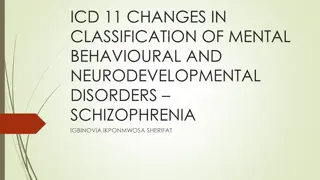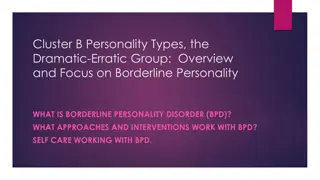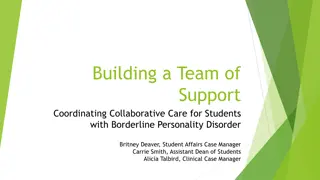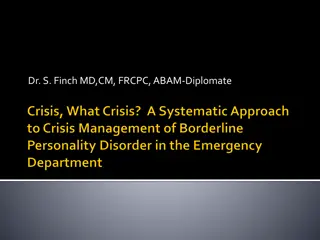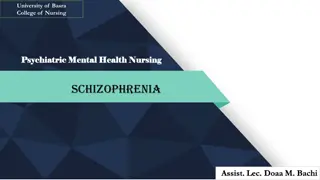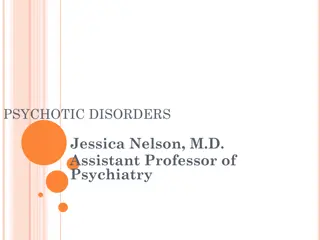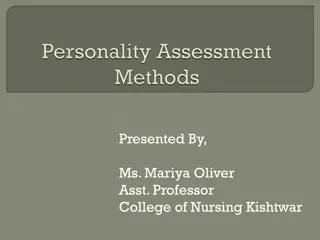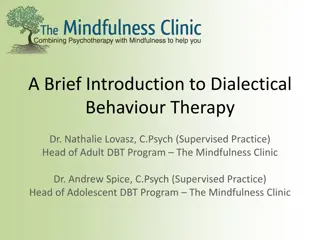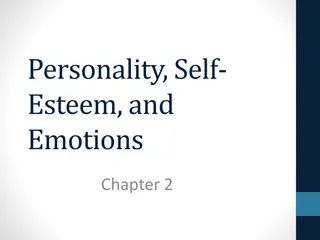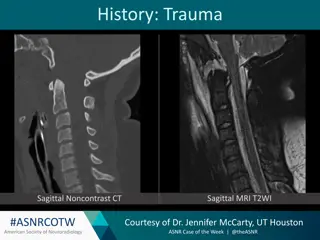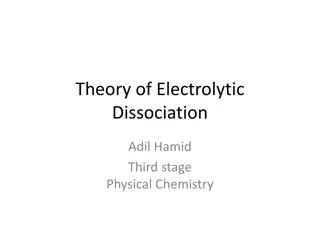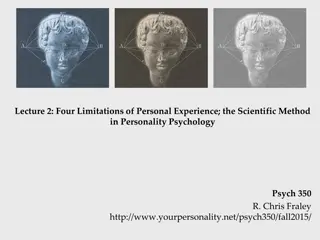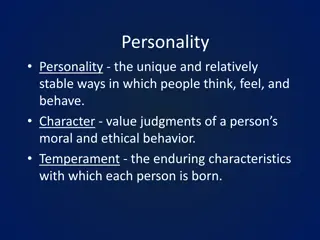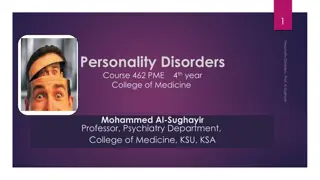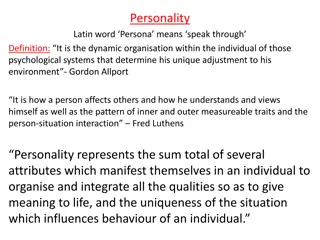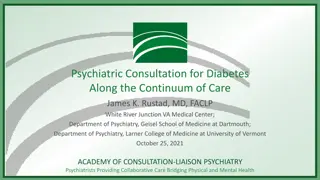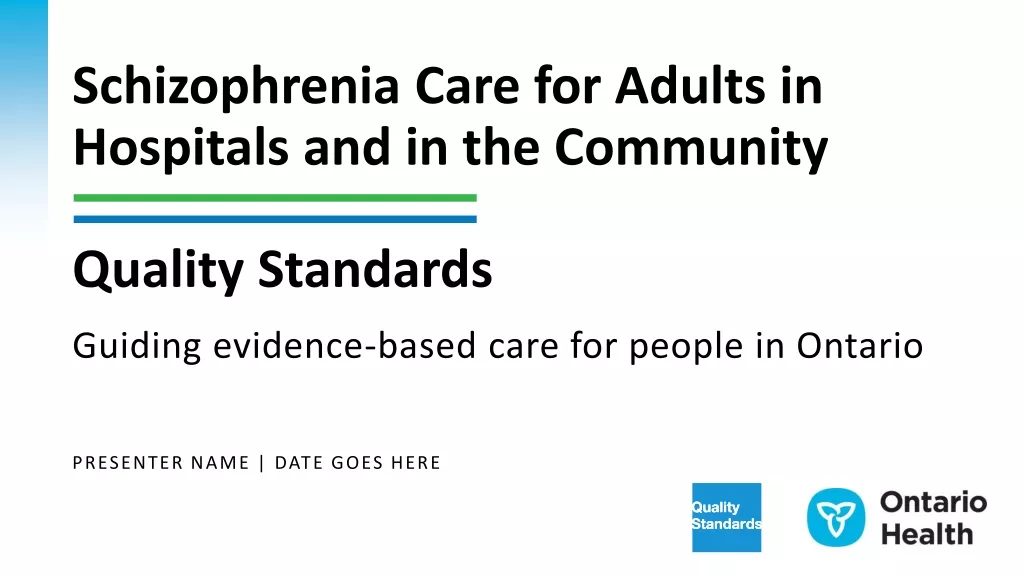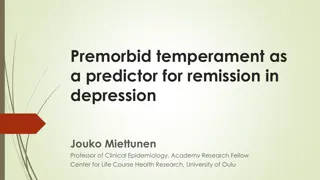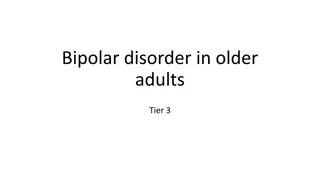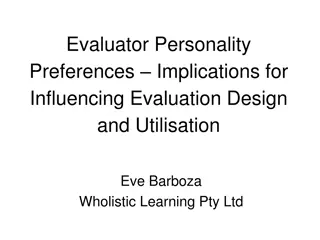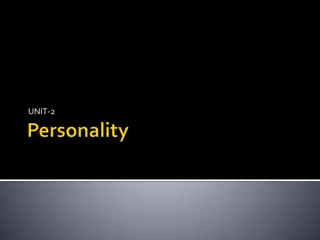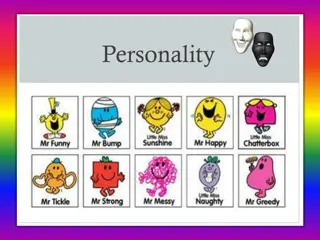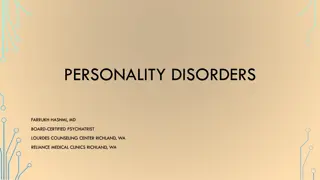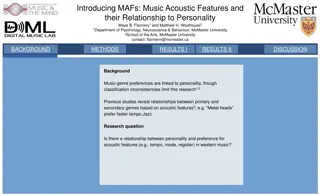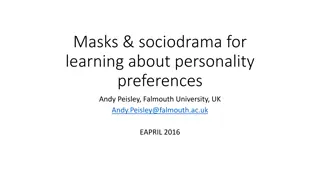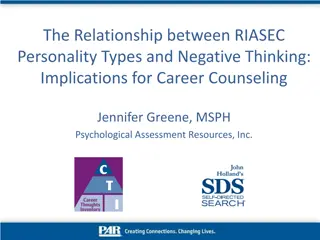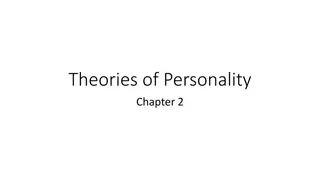Understanding Schizophrenia, Dissociation, and Borderline Personality Disorder
Clinical challenges and treatment approaches for schizophrenia, dissociative identity disorder, and borderline personality disorder are discussed in this content. The genetic and environmental factors influencing these conditions are explored, along with insights from twin studies and treatment efficacy data on medications like Seroquel. The content also highlights the importance of individual susceptibility loci identification in understanding the complexities of schizophrenia.
Download Presentation

Please find below an Image/Link to download the presentation.
The content on the website is provided AS IS for your information and personal use only. It may not be sold, licensed, or shared on other websites without obtaining consent from the author. Download presentation by click this link. If you encounter any issues during the download, it is possible that the publisher has removed the file from their server.
E N D
Presentation Transcript
Dissociation, Schizophrenia and Borderline Personality Disorder: Clinical Challenges During Hospitalization and Working With Voices In An Outpatient Setting Colin A. Ross, M.D. Krisiansand, Norway June 4, 2015 The Goal: Fluidity of Spirit
COLIN A. ROSS, M.D. 1701 Gateway, Suite 349 Richardson, Texas 75080 Phone: 972-918-9588 Fax: 972-918-9069 e-mail: rossinst@rossinst.com www.rossinst.com
TYPICAL VIEWS OF SCHIZOPHRENIA AND DISSOCIATIVE IDENTITY DISORDER Schizophrenia is a genetic brain disease treated with medication. Schizophrenia is not split personality. Schizophrenia is not caused by bad parenting. Dissociative identity disorder is a reaction to the environment to bad therapy to childhood trauma treated with benign neglect or psychotherapy.
KENNETH S. KENDLER, M.D. Dean Award Lecture American College of Psychiatrists 2/21/98 San Juan, Puerto Rico The Genetics of Schizophrenia: Toward the Identification of Individual Susceptibility Loci Most if not all of the reason why schizophrenia runs in families is due to shared genes and not to shared environment.
KENDLER TWIN STUDY Screened 16,000 twin pairs who had served in the U.S. Armed Forces, mostly in WWII and Korea MZ DZ Concordance for schizophrenia: 31% 6%
EFFICACY DATA ON SEROQUEL (QUETIAPINE) Kasper and Muller-Spahn, Expert Opinion in Pharmacotherapy 2000; 1: 783-801. Percentage of subjects with a reduction in BPRS scores of 40% or greater 35 150 mg 30 300 mg 25 75 mg 20 15 10 5 0 Zyprexa Study (Olanzapine) Placebo Seroquel Study
THE NIMH CLINICAL ANTIPSYCHOTIC TRIALS OF INTERVENTION EFFECTIVENESS (CATIE) New England Journal of Medicine (2005), 353-1209-1223.. $24 million 1,460 patients 18 months Dropout rate = 74% Seroquel response rate = 29.2% 0.29 x 0.26 = 7.5%
THE NIMH TREATMENT OF EARLY ONSET SCHIZOPHRENIA SPECTRUM STUDY(TEOSS) Journal of the American Academy of Child and Adolescent Psychiatry (2010), 49, 583- 594. 116 patients Age 8-19 52 weeks 14/116 (12%) in study after 52 weeks significant side effects and weight gain noted
POSITIVE SYMPTOMS OF SCHIZOPHRENIA AND COMORBIDITY IN THE GENERAL POPULATION ( N = 502 ) Type of Trauma No Positive Symptoms ( N = 397 ) % 5.8 Three or More Positive Symptoms ( N = 35 ) % 22.9 P Physical Abuse .0007 Sexual Abuse 5.0 25.7 .00001 Physical and/or Sexual Abuse 8.1 45.7 .00001
POSITIVE SYMPTOMS OF SCHIZOPHRENIA AND COMORBIDITY IN THE GENERAL POPULATION ( N = 502 ) Symptom Cluster Symptoms ( N = 397 ) DES 9.7 Somatic 1.0 Secondary Features of DID Borderline Criteria ESP/Paranormal 1.2 No Positive Three or More Positive Symptoms ( N = 35 ) 16.1 2.1 1.8 P .0002 .0003 .00001 0.5 0.4 2.0 .00001 2.9 .00001
SYMPTOM CLUSTERS CHARACTERISTIC OF TRAUMATIZED SCHIZOPHRENICS Symptom Cluster Abused Not Abused (N=37) Average Number of Items Positive (N= 46) p DES Score Schneiderian Somatic Secondary Features Of MPD Borderline criteria ESP/Paranormal Amnesia Items 21.6 6.3 4.7 5.3 8.5 3.3 1.3 2.3 .00001 .0002 .0002 .00001 4.1 6.6 2.5 1.5 2.8 1.2 .00001 .00001 .00001
DIS ITEMS CHARACTERISTIC OF TRAUMATIZED SCHIZOPHRENICS Abused Not Abused (N=37) (N=46) Item Ideas of reference Voices commenting Paranoid ideation Thought insertion Visual hallucinations Reading someone Else's mind % of Subjects Positive p 77.1 68.6 54.3 48.6 45.7 37.1 39.1 26.1 26.1 17.4 21.7 13.0 .002 .0003 .02 .006 .04 .03
PANSS SCORES CHARACTERISTIC OF TRAUMATIZED SCHIZOPHRENICS Abused (N=37) Not Abused (N=46) Scale Average Score p Positive Symptoms Negative Symptoms 17.7 21.0 .06 Compositive Score +2.6a -5.3b 0002 20.4 15.7 .002 a75th percentile for schizophrenia b35th percentile for schizophrenia
DEMOGRAPHIC DIFFERENCES BETWEEN MPD AND SCHIZOPHRENIA SUBJECTS MPD (N = 166) Schizophrenia (N = 83) Item Average Value p Value Average Age Average Number of Children 31.8 1.0 41.9 0.6 .00001 .02 % Female 89.2 30.9 .00001 % Married 30.1 13.3 .006 % Employed 45.5 9.9 .00001
CONCURRENT DIAGNOSES IN MPD AND SCHIZOPHRENIA MPD (N = 166) Schizophrenia (N = 83) p Value Percentage of Subjects Positive Diagnosis Psychogenic Amnesia Psychogenic Fugue Depersonalization Disorder MPD Somatization Disorder Substance Abuse Depression Borderline Personality Disorder 75.9 13.9 60.8 94.6 39.8 51.2 89.8 61.4 36.1 3.6 28.9 25.3 4.8 43.4 53.0 21.7 .00001 .03 .00001 .00001 .00001 ns .0001 .0001
DISSOCIATIVE SYMPTOMS IN MPD AND SCHIZOPHRENIA MPD (N = 166) Schizophrenia (N = 83) Symptom Cluster Average Number of Symptoms Positive P Value DES Score Somatic Schneiderian Secondary Features of MPD Borderline Criteria ESP/Paranormal Experiences 39.7 14.1 6.5 10.2 5.1 5.3 14.2 2.8 4.6 3.6 2.6 4.5 .00001 .00001 .00001 .00001 .00001 ns
Trauma Histories Among Inpatients With Dissociative Identity Disorder (DID), Borderline Personality Disorder (BPD), Both or Neither on the Dissociative Disorders Interview Schedule (DDIS) DID+BPD (N=37) DID (N=9) BPD (N=35) (N=19) Neither % Physical abuse Sexual abuse Physical and/or sexual abuse 86.5 91.9 100.0 77.8 66.7 77.8 68.6 74.3 82.9 52.6 68.4 73.7 Average Total trauma score 72.0 58.0 38.7 31.9 Ross, C.A., & Farrelly, L. (2014) Journal of Trauma and Dissociation, 15, 75-90.
Symptom Clusters Among Inpatients With Dissociative Identity Disorder (DID), Borderline Personality Disorder (BPD), Both or Neither on the Dissociative Disorders Interview Schedule (DDIS) and Dissociative Experiences Scale (DES) Scores DID+BPD (N=37) DES 51.3 DES-Taxon membership 100.0 DID BPD Neither (N=9) (N=35) (N=19) 44.8 18.7 13.5 % 100.0 56.7 50.0 DDIS Secondary features of DID Amnesia items Borderline criteria Schneiderian symptoms Somatic symptoms Conversion symptoms ESP/Paranormal experiences Suicide attempts 10.3 3.2 6.9 5.9 13.2 2.2 5.4 2.4 9.3 3.3 2.9 4.0 7.8 1.4 4.2 1.0 3.1 1.6 6.1 2.8 8.0 1.0 2.6 1.8 2.2 1.8 2.3 1.7 7.8 1.2 2.7 0.6
Symptom Cluster Scores Among Inpatients With Dissociative Identity Disorder (DID), Borderline Personality Disorder (BPD), Both or Neither on the Dissociative Trance Disorder Interview Schedule (DTDIS) DTDIS Section Traditional treatment Identity changes Environmental precipitants Memory Dissociative trance Cognition Physical/somatic DSM-IV Trance Possession Symptom score Total score DID+BPD (N=37) 3.1 5.6 4.5 3.8 4.0 2.8 6.4 2.4 25.0 32.6 DID (N=9) 1.6 4.0 2.2 1.4 2.0 1.1 2.9 1.1 12.6 16.3 BPD (N=35) 0.6 2.0 1.7 1.4 1.3 1.1 2.2 0.5 8.4 10.7 Neither (N=19) 0.4 1.2 0.6 0.4 0.2 0.1 0.6 0.2 2.6 3.6
TWO - YEAR PROSPECTIVE FOLLOW UP ON SUBJECTS WITH SCHIZOPHRENIA AND SCHIZOAFFECTIVE DISORDER ( N = 36 ) SCID 1993 1995 p X X2 % % Schizophrenia or Schizoaffective 100% 26.5 25.0 <.001 t p Axis I 5.7 3.0 6.7 .0001 Axis II 3.5 2.3 2.5 .02
TWO - YEAR PROSPECTIVE FOLLOW UP ON SUBJECTS WITH SCHIZOPHRENIA AND SCHIZOAFFECTIVE DISORDER ( N = 36 ) Dissociative Disorders Interview Schedule 1993 1995 t p Schneiderian Symptoms 6.7 3.9 5.3 .0001 Somatic Symptoms 18.2 10.4 6.5 .0001 Secondary Features of DID 11.8 8.5 5.8 .0001 Borderline Criteria 5.7 3.4 5.1 .0001 ESP 6.9 3.2 8.4 .0001
TALKING TO THE VOICES Mid-50s married Catholic woman with schizoaffective diagnosis Current life situation stable, good marriage Trials of numerous meds, 2 courses of ECT transient response to first course, no response to second course short-term memory impairment since ECT and TMS being considered Chronically depressed x 10 years with hostile, critical command hallucinations of suicide One voice sounds like her verbally, sexually and physically abusive father She believes the voice is literally her deceased father who has total control over her Has had some trauma therapy but no work with her voices Timid, quiet, no expressed affect, no facial expression, low energy
TALKING TO THE VOICES Explain that a physician does not talk to your knee Explain alternative model like your conscience talking to you = part of yourself Explain that goal is not to get rid of voices Establish that voice has been present since before dad died Establish that she has to kill herself to join her dad in Hell because that s what he wants and he has control Talk through to voice and establish that it is listening and can answer Suggest that she and her voice could make friends, form a team and work together Find out that the voice likes baseball Detroit Tigers dad did not like baseball also likes Bruce Springsteen dad did not Find out that voice does not like Notre Dame football dad did Point out that no one in their right mind would like Notre Dame football (voice laughs) Find out that voice likes flamingoes dad did not


